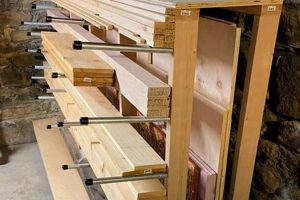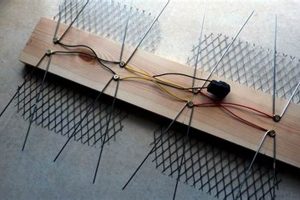Structures assembled on-site by the purchaser, typically utilizing pre-engineered steel components, represent a cost-effective and customizable construction solution. These readily available packages provide all necessary materials and instructions for erecting a building, ranging from simple storage sheds to expansive workshops. A common example involves the erection of a garage using a pre-fabricated frame, sheeting, and hardware included within the kit.
The appeal of these building methods lies in their potential for significant cost savings, driven by reduced labor expenses. Furthermore, the inherent design flexibility allows for adaptation to specific needs, such as accommodating unusual lot sizes or integrating particular functional requirements. The development of these systems has evolved from post-World War II industrial applications to encompass a broad range of residential and commercial building scenarios.
Subsequent discussion will delve into the critical considerations for successful implementation, including site preparation, foundation requirements, and the tools necessary for assembly. An evaluation of different structural designs and material options will also be presented, alongside a comprehensive overview of applicable building codes and permit processes.
Essential Considerations for Steel Structure Self-Assembly
Successful erection of a prefabricated steel building demands meticulous planning and adherence to established best practices. Neglecting these fundamental aspects can compromise structural integrity and lead to costly delays.
Tip 1: Comprehensive Site Evaluation: A thorough assessment of the building site is paramount. Examine soil composition, drainage patterns, and potential obstructions. Soil testing is advisable to determine load-bearing capacity and inform foundation design.
Tip 2: Adherence to Engineering Specifications: Strictly follow the engineering drawings and assembly instructions provided with the structure. Any deviation, however minor, can compromise the structural integrity and void warranties. Consult with a qualified engineer for clarification on any ambiguous details.
Tip 3: Accurate Foundation Construction: The foundation serves as the critical base for the entire structure. Ensure precise dimensions, levelness, and proper curing of concrete. Anchor bolts must be accurately embedded according to the specified layout to ensure proper attachment of the steel frame.
Tip 4: Proper Equipment Utilization: Employ the appropriate tools and equipment for lifting, aligning, and fastening steel components. Scaffolding, cranes, and specialized bolting tools are often necessary for safe and efficient assembly. Ensure all equipment is in good working order and operated by trained personnel.
Tip 5: Safe Working Practices: Implement rigorous safety protocols throughout the construction process. Require the use of personal protective equipment, including hard hats, safety glasses, and gloves. Establish a clear communication system and ensure workers are trained in safe lifting and erection techniques.
Tip 6: Secure Material Storage: Store steel components in a dry and organized manner to prevent corrosion and damage. Proper inventory management is crucial to ensure all parts are accounted for before commencing assembly.
Tip 7: Professional Inspection: Engage a qualified building inspector to conduct periodic inspections throughout the construction process. This helps to identify potential issues early and ensure compliance with relevant building codes.
Diligent adherence to these guidelines will significantly enhance the likelihood of a successful and structurally sound project. This proactive approach minimizes potential risks and contributes to the long-term performance of the erected structure.
The subsequent section will address specific material choices and their implications for structural performance and longevity.
1. Pre-engineered components
Pre-engineered components form the foundational basis of these assembly structures. Their precise design and manufacturing are paramount, as they dictate the building’s structural integrity and ability to withstand environmental loads. The accuracy of these components is a direct cause of the kit’s feasibility; without it, on-site assembly becomes impractical, requiring extensive custom fabrication and specialized expertise. An example of their importance can be seen in the standardized bolt patterns and connection points of the steel framing. Deviations, even minute, can create significant challenges during assembly and compromise the building’s overall stability. These components are crucial as it allows for easy installation, which is aligned with the DIY metal building kits concept, reducing the needs of a professional installer.
The use of pre-engineered components affects various facets of a project. These elements frequently encompass structural steel beams, columns, roofing panels, and wall cladding, all designed to interlock and connect with minimal on-site modification. Their importance also manifests in the streamlining of the permitting process. When accompanied by certified engineering drawings, pre-engineered designs can facilitate faster approvals, as local building departments are presented with a clear and verifiable structural plan. For instance, a properly engineered framing system can demonstrate compliance with wind load and seismic requirements, expediting the review process and reducing potential delays.
In summary, pre-engineered components are an indispensable aspect of the metal construction kits, enabling efficient assembly, structural reliability, and streamlined regulatory compliance. Challenges may arise in ensuring the accuracy of site measurements to match the pre-engineered dimensions, requiring careful attention during foundation preparation. Understanding the role and limitations of these components is crucial for achieving a successful outcome.
2. Foundation requirements
Adequate foundation design is paramount for structural integrity. With these structures, a robust foundation ensures stability, prevents settling, and distributes loads effectively. Neglecting proper foundation specifications can compromise the entire building, rendering the self-assembly process futile.
- Soil Bearing Capacity Assessment
Soil composition and bearing capacity dictate foundation type and dimensions. Sandy soil requires different foundation considerations than clay soil. Inadequate assessment may result in foundation failure and structural instability. For instance, a building placed on poorly compacted soil may experience differential settling, leading to cracks in the foundation and walls.
- Foundation Type Selection
Slab-on-grade, pier and beam, and stem wall foundations repre
sent common options. Slab-on-grade foundations are suitable for stable soil conditions and lighter loads. Pier and beam foundations offer advantages in areas with expansive soils or flooding risks. Stem wall foundations provide a perimeter wall for added support and protection. The selected type must align with site conditions and building design to ensure long-term stability. For example, a building in a high-wind zone may require a reinforced stem wall foundation. - Accurate Dimensioning and Leveling
Precise dimensions and level surfaces are crucial for proper frame alignment and load distribution. Deviations from specified measurements can introduce stress points and structural weaknesses. Laser leveling equipment and precise surveying techniques are essential for achieving accurate foundation construction. For example, if the foundation is not level, the steel frame may be subjected to uneven stress, leading to potential failures at connection points.
- Anchor Bolt Placement and Embedment
Proper anchor bolt placement and embedment ensure secure attachment of the steel frame to the foundation. Anchor bolts must be accurately positioned and embedded at the specified depth to provide adequate resistance to uplift and lateral forces. Inadequate anchor bolt installation can compromise the building’s ability to withstand wind loads and seismic activity. For example, a failure to properly embed anchor bolts can lead to the roof separating from the walls during a high-wind event.
The foundation serves as the critical interface between the structure and the ground. Understanding soil properties, selecting the appropriate foundation type, ensuring accurate dimensions, and properly installing anchor bolts represent essential steps for successful completion. Therefore, a well-executed foundation is not merely a component but a prerequisite for realizing the cost-saving benefits of the metal structure package.
3. Assembly complexities
The inherent cost advantages associated with self-assembled metal structures are often offset by the intricate nature of the assembly process. Understanding these complexities is essential for realistic project planning and successful implementation.
- Blueprint Interpretation and Component Identification
Effective execution requires a thorough comprehension of engineering blueprints and the ability to accurately identify and organize various components. Complexity arises from the sheer number of individual parts and the potential for misinterpretation, leading to errors in construction. For example, misidentifying a column support beam could result in structural instability and necessitate disassembly and rework.
- Heavy Lifting and Material Handling
Steel components are inherently heavy, demanding specialized equipment for safe and efficient handling. The absence of appropriate lifting devices, such as cranes or forklifts, can significantly impede progress and increase the risk of injury. For instance, attempting to manually lift a heavy roofing panel poses a safety hazard and can compromise the integrity of the panel itself.
- Precision Alignment and Fastening
Achieving precise alignment of structural members is critical for ensuring the building’s stability and longevity. Deviations from specified tolerances can create stress points and compromise the integrity of connections. The proper tightening of bolts and other fasteners, according to engineering specifications, is equally important. For example, under-tightening bolts can lead to joint slippage, while over-tightening can cause bolt failure.
- Weather Dependency and Site Logistics
Construction progress is often subject to weather conditions, particularly wind and precipitation. High winds can make it hazardous to lift and maneuver large components, while rain can create slippery surfaces and hinder welding activities. Efficient site logistics, including the organization of materials and equipment, is also crucial for minimizing delays. For instance, inadequate material storage can lead to components becoming damaged or misplaced, further complicating the assembly process.
These assembly complexities emphasize the importance of careful planning, skilled labor (or the willingness to acquire such skills), and the availability of appropriate equipment. While the prospect of cost savings is appealing, a realistic assessment of these challenges is essential for determining the feasibility of a DIY metal structure project.
4. Code compliance
Adherence to local building codes is not merely a suggestion but a legal requirement for metal structure kits. These codes establish minimum standards for structural safety, fire resistance, and energy efficiency, ensuring the erected structure meets specific performance criteria.
- Permitting Processes
Acquiring the necessary permits from local authorities is a prerequisite before commencing construction. The permitting process typically involves submitting detailed plans, including structural drawings and calculations, for review and approval. Failure to obtain permits can result in fines, construction delays, and even the forced removal of the structure. An example is providing detailed architectural drawings to the building permit office for approval. This documentation ensures that the proposed building design complies with local zoning regulations, including setbacks, height restrictions, and land use designations.
- Structural Requirements
Building codes dictate minimum structural requirements, such as wind load resistance, snow load capacity, and seismic design criteria. These requirements vary depending on geographic location and building occupancy. Kit manufacturers often provide pre-engineered designs that comply with relevant codes. However, it is the purchaser’s responsibility to verify code compliance and ensure the structure is properly installed to meet these requirements. For instance, in a high-wind zone, structures must be designed to withstand specific wind pressures. This requires the use of high-strength steel components, reinforced connections, and proper anchoring to the foundation.
- Fire Safety Regulations
Fire safety regulations mandate the use of fire-resistant materials and construction techniques to minimize the risk of fire spread and ensure safe egress in the event of a fire. Metal structures offer inherent fire resistance compared to wood-framed buildings. However, specific code requirements may dictate the use of fire-rated wall and roof assemblies, as well as fire suppression systems. As an example, a building intended for commercial use may require the installation of a sprinkler system, fire-resistant doors, and emergency lighting to comply with fire safety regulations.
- Energy Efficiency Standards
Energy efficiency standards aim to reduce energy consumption by requiring specific insulation levels, efficient windows and doors, and proper sealing to minimize air infiltration. Metal buildings can be designed to meet or exceed energy efficiency standards through the use of insulated metal panels, high-performance windows, and energy-efficient HVAC systems. For example, using insulated metal panels to reduce heat transfer and energy consumption.
These aspects of code compliance are integral to ensuring the safety, durability, and functionality of the building. Understanding and adhering to these requirements is crucial for avoiding legal complications and ensuring the long-term performance. Selecting a reputable supplier who provides code-compliant designs is highly advised for those attempting these projects.
5. Cost Implications
An evaluation of budgetary considerations is paramount when opting for self-assembled metal structures. While initial costs may appear lower, a comprehensive assessment of all potential expenses is crucial for accurate financial planning.
- Material Expenses and Kit Variations
The primary cost driver is the kit itself, with pricing influenced by size, complexity, and material quality. Thicker gauge steel, specialized coatings, and customized features inevitably increase the overall material expense. Comparing different kit options is essential to identify the optimal balance between cost and performance. Choosing a lower-grade kit to save money might involve spending more money on maintenance.
- Site Preparation and Foundation Costs
Site preparation and foundation construction represent significant ancillary expenses. Clearing vegetation, leveling the ground, and pouring a concrete slab incur considerable costs. Soil conditions may necessitate additional reinforcement or specialized foundation designs, further impacting the budget. A soil assessment is crucial to avoid expensive surprises related to foundation requirements. If the land is not level, this will add to the overall expenses.
- Equipment Rental and Tool Acquisition
Erecting a metal structure requires specialized equipment, such as cranes, forklifts, and welding machines. Renting or purchasing these tools represents a substantial investment. Furthermore, the acquisition of hand tools, safety gear, and other consumables adds to the overall cost. Improper equipment may lead to damage to the materials and the structure itself.
- Labor Costs and Skilled Assistance
While self-assembly aims to reduce labor expenses, many projects necessitate skilled assistance for certain tasks. Hiring a qualified electrician, plumber, or welder can add to the overall cost. Furthermore, the time commitment associated with self-assembly represents an opportunity cost. If time is money, the time spent should be calculated against expenses. The opportunity to work with a qualified building specialist may be worth the investment.
Comprehensive accounting for all these factors provides a realistic estimate of total project expenses. While self-assembled metal structures offer potential cost savings, a thorough understanding of all associated costs is essential for informed decision-making and effective budget management.
Frequently Asked Questions
This section addresses common inquiries regarding the procurement, assembly, and utilization of steel structure packages. The information provided aims to clarify key aspects and provide guidance for prospective builders.
Question 1: Are specialized skills required for erecting these structures?
While basic construction knowledge is beneficial, no highly specialized skills are invariably required. However, familiarity with blueprint reading, basic tool operation, and safe lifting practices is strongly recommended. Complex projects or those involving welding may necessitate professional assistance.
Question 2: What foundation types are compatible with metal structure packages?
The suitability of a foundation type depends on soil conditions, building size, and local code requirements. Common options include slab-on-grade, pier and beam, and stem wall foundations. A qualified engineer should assess site conditions to determine the optimal foundation design.
Question 3: How long does it typically take to assemble a metal structure package?
Assembly time varies based on building size, complexity, and crew size. A small storage shed may take a few days, while a larger workshop or garage could require several weeks. Careful planning, adequate preparation, and efficient workflow can significantly reduce assembly time.
Question 4: Are these structures resistant to rust and corrosion?
Metal components are typically coated with protective finishes, such as galvanization or powder coating, to enhance corrosion resistance. However, regular maintenance, including cleaning and touch-up painting, is essential to prevent rust and ensure long-term durability, especially in coastal or industrial environments.
Question 5: Can these structures be insulated for climate control?
Yes, metal structures can be effectively insulated using various methods, including batt insulation, spray foam insulation, and insulated metal panels. Proper insulation is crucial for maintaining comfortable indoor temperatures and reducing energy costs.
Question 6: What are the typical uses for metal structure packages?
These structures serve a wide range of purposes, including storage sheds, garages, workshops, agricultural buildings, commercial spaces, and residential dwellings. Their versatility and cost-effectiveness make them a popular choice for diverse applications.
In summary, these kits provide a flexible building solution contingent on realistic assessment, careful preparation, and adherence to sound construction principles.
The next section will offer a comparative analysis of different manufacturers and suppliers, providing guidance for selecting a reputable provider.
DIY Metal Building Kits
The preceding analysis has dissected the core elements associated with structures acquired in kit form and erected by the purchaser. Critical considerations encompass site evaluation, foundation requirements, assembly complexities, code compliance, and a thorough evaluation of costs. The successful completion of such a project is contingent upon meticulous planning, adherence to engineering specifications, and a realistic appraisal of the time and effort commitment.
The viability of steel construction packages as a construction solution hinges upon a comprehensive understanding of the inherent challenges and responsibilities. Potential builders should prioritize rigorous preparation and seek professional guidance when necessary to ensure a structurally sound and code-compliant final product. Failure to do so can negate purported cost savings and compromise the long-term integrity of the investment.







